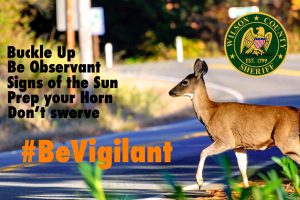
As deer season continues, there have been numerous vehicle related accidents involving collisions with deer across our area. Although many times they are unavoidable, here are some tips to keep in mind as you travel the roadways.
- Buckle up! Seat belts are designed to protect you from a collision or sudden stop — which is exactly what happens when you’re faced with a deer on the highway. The easiest way to help you and your family safe is by buckling up.
- Be observant. Deer crossings are there for a reason — to warn you that the area you’re driving in is heavily populated with deer or common areas deer cross. Be on the lookout and take extra caution when you see these signs. And remember that deer often travel in groups, so where you only see one, chances are there are more around.
- Recruit your passengers. The more people watching for deer, the better. Tell your passengers to be on the lookout and warn you if they see any deer. Even if they see deer grazing in fields far from the road, this could potentially mean more deer are around and trying to cross over.
- Signs of the sun — Dawn and dusk are times deer are most active because it’s when they are commonly on the hunt for food. This is also the time of day when visibility is much lower and your vision isn’t at its best.
- Prep your horn — Deer often fixate on headlights, so it may not be effective enough to just flash your lights. Since they’re easy to spook, brake firmly and honk your horn.
- Don’t swerve — If it’s apparent that a crash is unavoidable, whether it is a deer or other animal crossing the road, do not swerve. Studies show that more serious crashes occur when drivers swerve to avoid an animal. Swerving could cause you to lose control of your vehicle and possibly roll over or hit another car or object.
